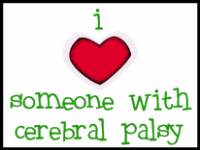In a discussion about rude behavior/comments with another mom of a CP kid, she mentioned that one time someone actually stepped through her child's walker because he wasn't moving fast enough. Just another example of how people can be so unaware of the feelings of people with disabilities. It's a totally different situation, but I also feel like Clayton's "personal space" is being invaded when other kids climb all over his wheelchair and/or play excessively with his horn or mess with his O2 tank. Kids don't really know any better, so I decided to post an FYI for the adults--maybe it will trickle down to the kids that way . . .(I've highlighted the ones that are most important to us).
**Always ask the person using the wheelchair if he or she would like assistance BEFORE you help. It may not be needed or wanted.
**The first rule of etiquette when interacting with people in wheelchairs, or power chairs, is to remember that one should not focus on their disability. Instead, focus on the person. Another rule of etiquette is the act of shaking hands, even if their limbs are limited in use. Focus on the person, not on his or her disability.
**People who use wheelchairs have varying capabilities. Some persons who use wheelchairs can walk with aid or for short distances. They use wheelchairs because they help them to conserve energy and to move about with greater efficiency.
**Don't classify or think of people who use wheelchairs as "sick." Wheelchairs are used to help people adapt to or compensate for the mobility impairments that result from many non-contagious impairments.
**Don't pet guide dogs or other service animals as they are working animals.
**It is appropriate to shake hands with a person who has a disability, even if they have limited use of their hands or wear an artificial limb.
**If your conversation lasts more than a few minutes, consider sitting down, etc. to get yourself on the same eye-level as the person who uses the wheelchair. It will keep both of you from getting a stiff neck!
**If you have children, they will stare, it's their nature. Talk to the child about disabled people, and help them to understand why people use wheelchairs. Don't discourage children from asking questions of a person who uses a wheelchair about their wheelchair. Open communication helps overcome fearful or misleading attitudes.
**Bathroom breaks matter. If you plan a gathering or meeting and observe someone in a wheelchair, ensure the person knows and has access to a bathroom.
**Don't hang or lean on a person's wheelchair because it is part of that person's personal body space.
**Speak directly to the person in the wheelchair, not to someone nearby as if the person in the wheelchair did not exist.
**Don't belittle or patronize the person by patting them on the head.
**Give clear directions, including distance, weather conditions and physical obstacles that may hinder the person's travel.
**When a person using a wheelchair "transfers" out of the wheelchair to a chair, toilet, car or bed , do not move the wheelchair out of reaching distance.
**Be aware of the person's capabilities. Some users can walk with aid and use wheelchairs to save energy and move quickly.
**The first rule of etiquette when interacting with people in wheelchairs, or power chairs, is to remember that one should not focus on their disability. Instead, focus on the person. Another rule of etiquette is the act of shaking hands, even if their limbs are limited in use. Focus on the person, not on his or her disability.
**People who use wheelchairs have varying capabilities. Some persons who use wheelchairs can walk with aid or for short distances. They use wheelchairs because they help them to conserve energy and to move about with greater efficiency.
**Don't classify or think of people who use wheelchairs as "sick." Wheelchairs are used to help people adapt to or compensate for the mobility impairments that result from many non-contagious impairments.
**Don't pet guide dogs or other service animals as they are working animals.
**It is appropriate to shake hands with a person who has a disability, even if they have limited use of their hands or wear an artificial limb.
**If your conversation lasts more than a few minutes, consider sitting down, etc. to get yourself on the same eye-level as the person who uses the wheelchair. It will keep both of you from getting a stiff neck!
**If you have children, they will stare, it's their nature. Talk to the child about disabled people, and help them to understand why people use wheelchairs. Don't discourage children from asking questions of a person who uses a wheelchair about their wheelchair. Open communication helps overcome fearful or misleading attitudes.
**Bathroom breaks matter. If you plan a gathering or meeting and observe someone in a wheelchair, ensure the person knows and has access to a bathroom.
**Don't hang or lean on a person's wheelchair because it is part of that person's personal body space.
**Speak directly to the person in the wheelchair, not to someone nearby as if the person in the wheelchair did not exist.
**Don't belittle or patronize the person by patting them on the head.
**Give clear directions, including distance, weather conditions and physical obstacles that may hinder the person's travel.
**When a person using a wheelchair "transfers" out of the wheelchair to a chair, toilet, car or bed , do not move the wheelchair out of reaching distance.
**Be aware of the person's capabilities. Some users can walk with aid and use wheelchairs to save energy and move quickly.
**It is ok to use terms like "running along" when speaking to a person who uses a wheelchair. The person is likely to express things the same way.
**Don't assume that using a wheelchair is in itself a tragedy. It is a means of freedom that allows the person to move about independently.
**Don't assume that using a wheelchair is in itself a tragedy. It is a means of freedom that allows the person to move about independently.
(This is a direct copy/paste from this post at www.disabled-world.com This article also talks about teaching your kids about disabilities.)
This announcement has been brought to you by a sensitive mom of a child in a wheelchair. :)



3 comments:
Sometimes people need to be educated Ashley. Thanks for the information. There were a few things there that I did/would not think of. Thanks
Thank you Ashley for a well thought out version of etiquette! Our daughter is also in a wheelchair and we have faced alot of the same issues. You might want to consider of actually publishing this for the public. It truly would be a public service!
This is A+ etiquette. I too have a child in a wheelchair and am flaborgasted by society in general. Why is it that somehow disabilities have become taboo! Nobody can open their mouths to say hi. It's been reduced to jaw dropping and ridiculous staring. A shame. I wish more people could read this!
Post a Comment